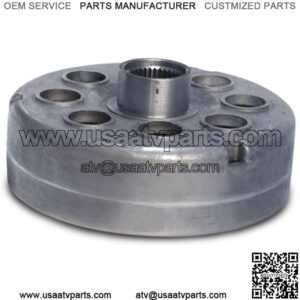A drum brake is a type of brake used in many vehicles – especially in rear brakes.
It uses the friction generated by brake shoe pads when they rub against a rotating cylinder-shaped brake drum. This friction converts kinetic energy into thermal energy and decelerates the vehicle.
It’s important to note that the whole drum brake assembly is usually fitted to the back plate of the wheel and does not rotate with the backing plate.
What Are The Main Components Of Drum Brakes?
Let’s look at the different drum brake components:
1. Brake Drum
Brake drums are large metal discs made of cast iron or aluminum that are bolted to the hub of the wheel. They rotate along with the hub and form a frictional pair with drum brake shoes to slow your car down.
2. Brake Shoe
The brake shoe or brake pad is a curved piece of metal fitted on the rear wheel. These pads contain friction material inside the brake lining that pushes against the brake drum to stop the vehicle.
3. Wheel Cylinder
The wheel cylinder of your brake system contains a piston that moves outwards when the brakes are applied. The force of the piston pushes the brake shoe outwards and decelerates your vehicle.
4. Return or Retracting Spring
A return or a retracting spring pulls the brake shoes away from the drum’s friction surface when you let go of the brake pedal.
5. Self Adjuster
The self adjuster maintains the minimum gap between the brake shoe and drum to avoid contact with each other.
How Does A Drum Brake Work?
When you step on the brake pedal, your master cylinder compresses its fluid, and the piston of the wheel cylinder expands outward. The outward motion of the piston forces the brake shoe to press against the brake drum.
Just as the brake shoe lining touches the inner surface of the drum, the motion of the wheel reduces, and the vehicle stops.
When you take your foot off the brake pedal, the retracting springs draw the brake shoe inward — removing the contact between the drum brake lining and the shoe.
The 3 Different Types Of Drum Brakes
Here are the three main types of drum brakes that are used today:
1. Mechanical Drum Brakes
These are primarily used in two-wheelers.
In mechanical brakes, when you press the brake pedal, the brake cam turns, pushing the brake shoe outwards and rubbing it against the drum.
The friction between the brake linings and the drum slows down the rotation of the wheel — stopping the vehicle.
When you release the brake pedal, the brake spring retracts and brings the brake shoe back to its original position.
2. Hydraulic Drum Brakes
These drum brakes operate through the hydraulic pressure in your brake system.
When you press down on the brake pedal of your vehicle, the oil in the master cylinder increases the hydraulic force sent to the wheel cylinders. This forces the brake outwards.
Then, the wheel cylinder’s piston (instead of a cam) pushes the brake shoes, and the friction generated by the brake shoe rubbing against the drum decelerates the wheel.
3. Pneumatic Assisted Drum Brakes
Also referred to as air brake systems, these are similar to hydraulic brakes, but they use air, instead of fluid, in the braking system.
High-pressure compressed air actuates a pneumatic piston and turns the cam, which slows down your wheel.
These brakes are mostly found in heavy commercial vehicles such as heavy-duty trucks, buses, railroad locomotives, etc., because of their stopping power.
About Drum Brake
“drum brake”
“drum brake diagram”
“drum brake vs disc brake”
“drum brake tools”
“drum brake assembly”


